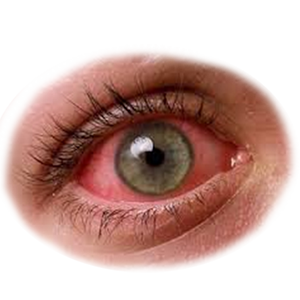
Pink Eye (Conjunctivitis) by Marilee Tapley
Have you looked in the mirror and asked yourself “why are my eyes so red?” You then hop online and type in a few key words and then you discover… you have PINK EYE! What do you do now? Here is some helpful information about pink eye.
Pink eye sounds scary, but this very common eye problem is easily treated and with a few simple precautions, it can be avoided. Pink eye is also known as conjunctivitis. It’s an inflammation or infection of the outer membrane that lines the eyelid. The inflammation makes the blood vessels more dilated, giving the eye a pink, reddish color.
There are two kinds of pink eye: viral and bacterial. Viral pink eye usually produces a watery discharge. Bacterial pink eye often produces a thick, yellow-green discharge. Both viral and bacterial pink eye are contagious and can spread easily. Poor hand-washing is the main cause of the spread of pink eye. You can catch pink eye from sharing objects in the workplace like pens, staplers, or door handles. It’s good practice at the office to keep your hands clean and avoid touching your face to reduce your chances of catching pink eye.
Viral pink eye can last 5-7 days, or in some cases, up to 3 weeks. Viral conjunctivitis is caused by a virus, like the common cold. This kind of pink eye is very contagious, but usually clears up on its own without medications. If you contract conjunctivitis, remove your contacts and wear glasses. Applying a cold, wet washcloth to the infected eye several times a day can help relieve your symptoms, like swelling, itchiness and burning.
Bacterial conjunctivitis is caused by bacteria and can cause serious damage to your eye if left untreated. A sticky, yellow or greenish-yellow eye discharge will develop in the corner of the eye. Bacterial conjunctivitis usually occurs from direct contact with t he bacteria such as shaking someone’s hands or opening a door that has the virus, then touching your eye. Most cases of pink eye are mild and tend to get better on their own, even without treatment. There are times where you need to see a doctor, in which they can prescribe ointment or drops.
he bacteria such as shaking someone’s hands or opening a door that has the virus, then touching your eye. Most cases of pink eye are mild and tend to get better on their own, even without treatment. There are times where you need to see a doctor, in which they can prescribe ointment or drops.
Allergic conjunctivitis is eye inflammation caused by common allergies such as mold, pet dander or pollen. The symptoms of allergic conjunctivitis consist of burning, eye redness, light sensitivity and itching. Allergic conjunctivitis is not contagious. Treatment is very similar to treating an allergy, such as using allergy medications, like antihistamines. Ask your physician for details.
Happy, healthy bright eyes are a sign of good health!
The information provided is for general interest only and should not be misconstrued as a diagnosis, prognosis or treatment recommendation. This information does not in any way constitute the practice of medicine, or any other health care profession. Readers are directed to consult their health care provider regarding their specific health situation. Marque Medical is not liable for any action taken by a reader based upon this information.
